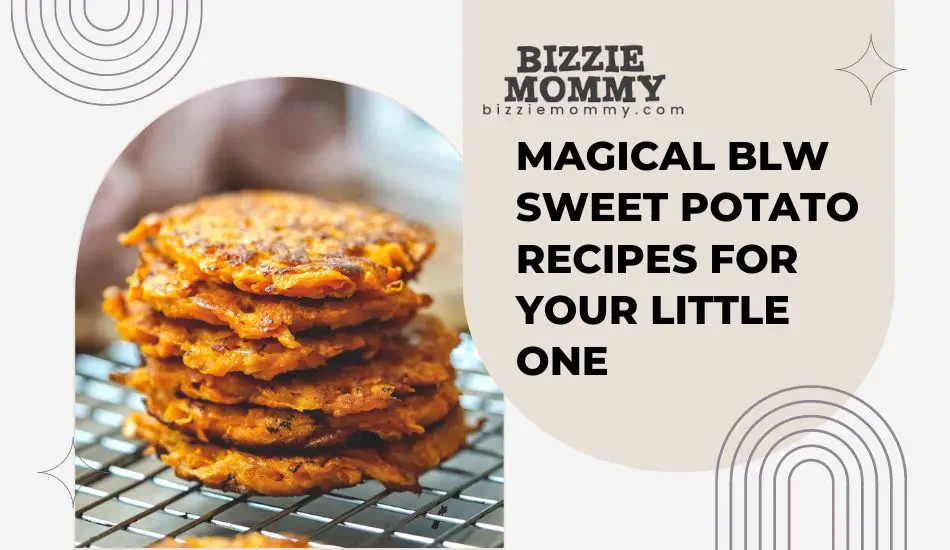Are you trying to find a baby meal that your baby will love and also be nutritious? If you are using a baby-led weaning (BLW) process, sweet potatoes might be just what you’re looking for! Sweet potato for baby-led weaning (BLW) is a great, delicious, low-cost option. Most infants like it, and it’s very easy to prepare. You can cook sweet potatoes in various ways to keep your baby interested, and they may even help alleviate baby constipation.
Sweet potatoes can be served as finger food for your baby. In most instances, they can be added to a baby’s diet at approximately the 6-month mark. Sweet potatoes are rich in minerals and vitamins, including Vitamin A, which is good for the eyes and a healthy immune system, and Vitamin C, which benefits teeth, gums, and bone health.
What is Baby-Led Weaning (BLW)?
Baby-led weaning (BLW) is a process that encourages infants to begin feeding themselves. Your baby will learn to explore and enjoy food via his hands and will start eating more and learning to chew and swallow better. Instead of purees, if you use baby-led weaning, you will offer your baby finger food that he or she can grab and explore. Baby-led weaning enables your child to develop self-control in their eating, the ability to focus their attention, and an appreciation for various tastes and textures.
You can begin BLW when your baby is around six months old or whenever he or she can sit up and begin self-feeding; however, be aware that not all babies benefit from BLW. Before beginning this eating regimen, consult your doctor.
Baby-led weaning will help your baby develop a healthy connection with food and learn to detect hunger and fullness cues with a varied diet of whole, natural foods. For BLW to begin, your baby will require finger food. Options may consist of anything from scrambled eggs, bananas, and avocados, to sweet potatoes, cooked carrot sticks, and little servings of meat. To avoid choking, avoid nuts, raw vegetables, and hard fruits.
Baby-led weaning aids in the maturation of fine motor skills. Picking up and placing small pieces of food in his or her mouth may help your newborn develop a better grip and finger strength. When properly fed, BLW is not dangerous; however, choking may occur. It’s crucial to understand the warning symptoms of infant choking and what to do if it occurs while eating.
When Should I Start Baby-Led Weaning (BLW)?
Most babies can start eating solid food at approximately six months of age. Babies at this age have good head and neck control, making it possible to feed them safely and efficiently while they are sitting up. At this age, they may even begin stealing food from others.
Some babies may need to wait until they are seven or eight months old before being ready for meals. Before beginning BLW, make sure you see these signs of readiness:
- Your baby must first learn how to hold his/her head up while sitting.
- Your baby has to be able to pick up food and feed himself.
- Loss of the tongue-thrust reflex that causes infants to spit up their meals, which is usually seen in babies between four and six months old.
- Your newborn shows interest in the food you and others eat by reaching for and grabbing it.
Start with one meal and wait before introducing another to discover allergies and intolerances. Don’t stop giving your little one breast milk or formula just because he or she is eating now.
Using BLW, you can help your newborn develop a positive relationship with food and learn to enjoy exploring various tastes and textures by providing age-appropriate finger foods and closely monitoring mealtimes.
Is Sweet Potato a Good Way to Start Weaning?
Introducing fully cooked sweet potatoes into the diet of your weaning baby is a very smart step. They are easy to prepare and have a subtly sweet taste that appeals to most babies. They are also full of immunity-enhancing health benefits.
To prepare sweet potatoes for your baby, you may bake, boil, or steam them until soft, then either mash them or provide them in finger-sized pieces. The flavor may be amplified by combining sweet potato puree with other foods.
It’s best to peel sweet potatoes before cooking. After feeding your baby sweet potatoes, carefully watch for signs of allergies since some infants may react to sweet potatoes. That is why you must introduce all foods very slowly into the baby’s diet. A baby’s digestive system needs at least three days to adjust to new foods and reveal any allergies or intolerances.
You may start with a small serving of sweet potatoes and gradually increase as your baby becomes used to eating solid food. Sweet potato puree can be combined with apple, pear, cinnamon, or nutmeg for additional taste.
How Can I Use Sweet Potato as a Meal?
Sweet potatoes are a great vegetable; you can use them in many ways as meals.
Sweet Potato Fries
These make delicious finger food for babies. Toss thin slices of sweet potatoes with olive oil and seasonings. Bake them until they are crispy.
Mashed Sweet Potato
Mashing the sweet potato for baby-led weaning is a common meal. Peel the potato then boil it and mash it, just like you would regular potatoes.
Sweet potato pancakes
Pancakes made of sweet potatoes provide a tasty, healthy meal. Mix mashed sweet potato with eggs, flour, and seasonings, then cook on a griddle or pan until golden brown.
How to Cook Sweet Potatoes?
Sweet potatoes for babies is a versatile and tasty vegetable that may be prepared in various ways including roasting, boiling, mashing, and frying. Some straightforward approaches to preparing sweet potatoes are:
Roasting:
To roast sweet potatoes, your oven needs to be preheated to at least 400 degrees Celsius. Puncture your sweet potatoes with a fork numerous times after washing and drying them. Put them on a baking tray, and toss them in the oven for 45 min –1 hour.
Boiling:
To prepare sweet potatoes for boiling, peel them and cut them into tiny pieces. Cook them for 15 to 20 minutes in a saucepan of boiling water or until they reach the desired tenderness.
Mashing:
To prepare mashed sweet potatoes, prepare them just as you would make boiled sweet potatoes. Boil them for 15–20 minutes, then drain them and mash them with any dairy or seasonings of your choice.
Steaming:
Steaming a sweet potato starts with peeling and chopping it into cubes. Put the sweet potato pieces in a steamer basket placed in the boiling water, and let them sit there until they are soft.
Whatever way you serve this versatile vegetable, make sure it is cool enough for your baby, and always keep an eye on your baby while they are eating to avoid choking hazards.
Ways to Serve Sweet Potatoes
During baby-led weaning (BLW), sweet potatoes are a wonderful first solid meal to introduce to your child. Babies will probably like their sweet flavor, and they are full of nutrients. Here are some suggestions for including sweet potatoes in your baby’s solid food diet:
- Just cut and bake to make sweet potato wedges for baby-led weaning. The wedges must be of the perfect size for your little one to hold without a problem.
- Boil or roast your sweet potatoes until tender, then mash them with breast milk or formula. Your infant will love this new texture and taste.
- Make sweet potato puree by cooking the sweet potatoes until they are soft and then blending or processing them until they are completely smooth. This may be eaten on its own or combined with other fresh produce for a more exciting meal.
- Pancakes made with mashed sweet potatoes, eggs, and flour, then fried on a pan or griddle till golden brown. If you want to introduce finger foods to your infant, try these pancakes.
Sweet potatoes are a nutrient-dense and delicious addition to your baby’s diet that he or she is sure to love. They are a delicious complement to any BLW meal, whether served as wedges, mashed, pureed, or pancakes.
BLW and Sweet Potato Wedges

During baby-led weaning, roasted sweet potato wedges are a wonderful solid meal for your child. They are the perfect first finger snack since they are soft and baby-friendly. There are various ways to cook sweet potato wedges, like frying, roasting, and baking. One easy and delicious method to cook sweet potato wedges is to roast them in the oven.
Ingredients Needed
To make roasted sweet potato wedges, you need the following ingredients:
- Sweet potato
- Olive oil or avocado oil
- Paprika
- Salt
Step By Step Instructions:
- The oven must be preheated to 400° F.
- Cut sweet potato lengthwise and then into 4 equal wedges to make 8 total wedges. Depending on the sweet potato, split the wedges in half.
- Oil and season the wedges with salt and paprika in a bowl. Toss sweet potato wedges with your hands to coat them.
- Put the sweet potatoes in the oven. After 12 minutes, flip the wedges and bake for 12-15 minutes more until they become soft on the inside and crispy and crunchy on the outside.
Instruments Needed
Sweet potato wedges are very easy to make. The few things you need to make them are:
- Knife
- Mixing bowl
- Vegetable peeler
- Parchment paper
- Baking tray
- Oven
Tips to Make Babies Eat Sweet Potatoes
It might be difficult to feed your newborn new foods, but sweet potatoes are a great option. Here are some strategies for getting infants to eat sweet potatoes:
- Introduce sweet potatoes, or any new foods, gradually by starting with small quantities. You can increase the amount of sweet potatoes your baby consumes as he or she becomes accustomed to their flavor and texture.
- Naturally sweet, sweet potatoes benefit from the addition of herbs and spices like cinnamon and nutmeg to bring out their full potential. This may help your infant like sweet potatoes.
- Several techniques can be used to prepare sweet potatoes because of their versatility, including roasting, boiling, and pureeing. Find out what your baby likes by experimenting with various preparations of sweet potato.
- When blended with other foods, such as fruits or vegetables, sweet potatoes might become more palatable to your infant. They make a perfect snack when combined with yogurt or applesauce.
Using these strategies, you can introduce sweet potatoes to your infant’s diet. It is important to be persistent and try various preparations until your baby develops a taste for them. Getting your baby to eat sweet potatoes could take a few tries, so have patience.
Final Thoughts
Sweet potatoes are excellent for baby-led weaning. They are rich in nutrients necessary for your baby’s development, including fiber, potassium, and vitamin A.
Sweet potatoes may be prepared in a wide variety of ways, including roasting, boiling, and pureeing, and then served as wedges, mashed, or even pancakes. You may improve the taste of sweet potatoes for your infant by combining them with other foods, such as fruits and vegetables, or by adding herbs and spices.
Remember to introduce sweet potatoes gradually and be patient. If your infant initially seems uninterested in sweet potatoes keep trying new ways of eating them until you find your baby’s preferred flavor and texture.
Adding sweet potatoes to your baby’s diet is a great way to spice up mealtime and give them a healthy dose of nutrients. Sweet potatoes are a nutritious addition to BLW since they are both filling and delicious. Try it out and see your infant’s face light up as they discover the deliciousness of sweet potatoes!

